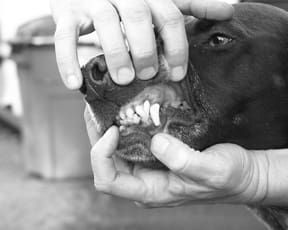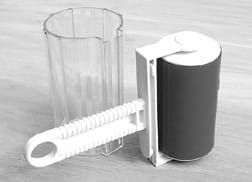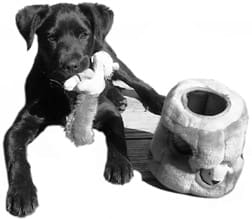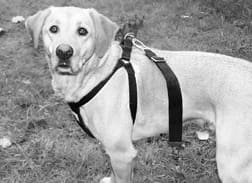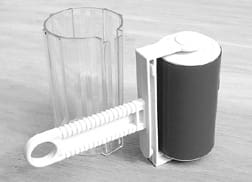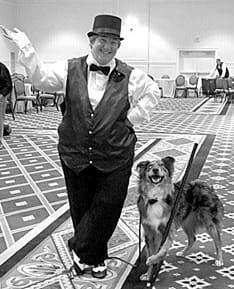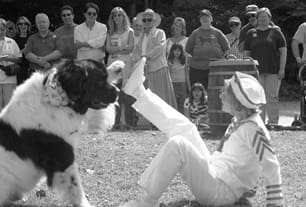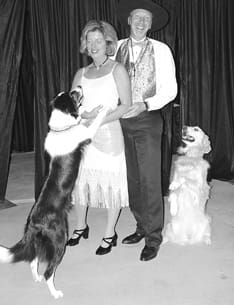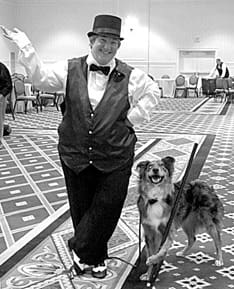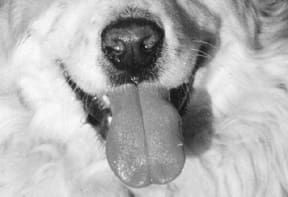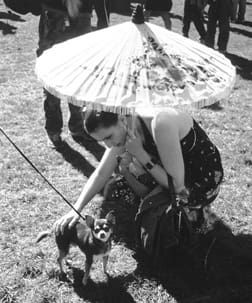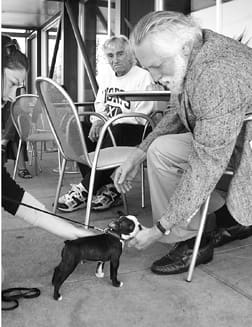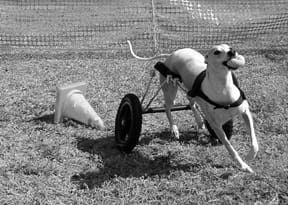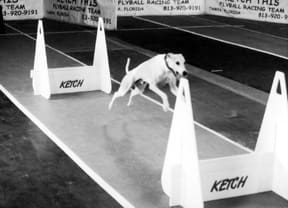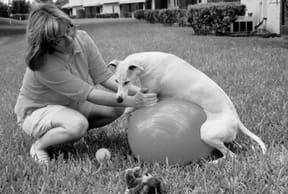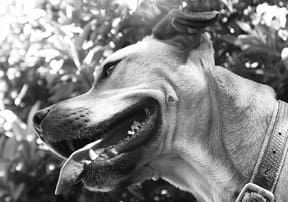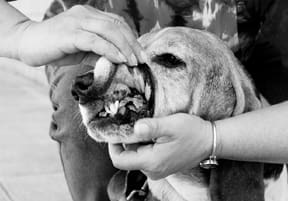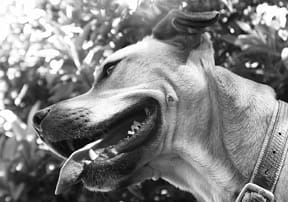Pokey and I are on the floor, man and beast in a playful tussle. I poke, scratch, pull, and tug on the genial Lab-mix, using my fingers and arms. I fake a left jab and poke him with my right hand. His only recourse is to duck and jump, first in retreat, then, with lips drawn in a mock snarl, pouncing on me and mouthing my hands and shirt. Fortunately, Pokey came from a family of nine puppies, cared for by seven home-schooled kids, so he was well socialized as a puppy and knows how to mouth-play without biting too hard.
A dog’s mouth is his most intimate connection to the outside world, his gateway for primary contact. He uses his mouth for sustenance, investigation, and communication. He uses his jaws as a tool; they can carry, crush, slice, gnaw, grind, or, as in Pokey’s case, gently grab and render my “superior” hands helpless.
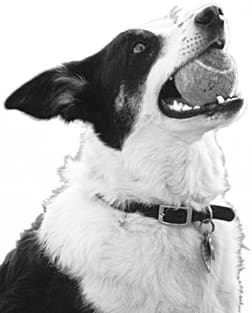
The mouth is also the beginning point for the dog’s harvest of life-sustaining nutrients. The initial identification of immune-stimulating substances contained in whatever the dog ingests starts in the mouth. The tonsils, lying deep in the mouth, are a prominent site of lymph tissue, and the mouth is lined with other lymphoid elements – all of which transport immune-sensing information to the rest of the body.
It is important to keep this “gateway” function of the mouth in mind as we consider how to best deliver remedies to enhance the innate immune system’s ability to respond. Herbs that contact the mouth’s lymphoid tissues (that is, herbal remedies not encased within capsules) have the advantage of stimulating this early alert, immune-enhancing lymphoid tissue.
But from the perspective of a veterinarian, a dog’s mouth is mostly a primary site of disease. Periodontitis (inflammation of the tissues surrounding a tooth) and dental calculus (an accumulation of mineral salts on teeth) are respectively the number one and number two problems seen in dogs over seven years of age. Periodontal disease is present in an estimated 50 to 80 percent of all dogs.
Furthermore, there is evidence that periodontitis also predisposes animals to a number of diseases such as heart disease, diabetes, and even respiratory disease. At least one (human) study has indicated that poor oral health is a stronger predictor of heart disease than markers such as fibrino-gen (a clotting factor and indicator of inflammation), low HDL (good) cholesterol, or high triglycerides.
In addition, endotoxins have been isolated from calculus residues on the teeth of dogs, and there is anecdotal evidence (perhaps related to the endotoxins) that dental disease may also be responsible for (or at least increase the likelihood of) other chronic diseases such as arthritis.
Unfortunately, when it comes to pointing the finger at who or what is to be blamed for much of our pets’ dental problems, “We have met the enemy, and they are us.” We have created at least a two-fold problem.
First, we have bred dogs for cuteness; many of the toy breeds have jaws too small to accommodate all their teeth. This forces teeth to grow abnormally and the resulting misalignments and malocclusions create foci for future calculus buildup. Second, our commercial foods don’t provide the tooth-cleansing effects of pulling meat and other soft tissues off raw bones, as well as time-consuming gnawing on raw hide and bones.
The canine mouth
The dog’s teeth and gums are the most important considerations in the mouth, both because the incidence of disease of the teeth and gums is so high, and because their influence on overall health and disease is so profound. However, I’ll briefly mention other structures of the oral cavity and oropharynx (an ill-defined area that includes the posterior part of the oral cavity and the pharynx) and give a brief list of potential problems that may occur in them.
The oral cavity is an open-ended tube that functions in prehension (the act of seizing or grasping), mastication (chewing), fluid intake, taste, and swallowing.
The relative size of the dewlap and amount of flesh associated with a dog’s lips are characteristic of the individual breed. Facial expressions are controlled by the lip muscles,which are innervated by the facial nerve. Several cranial nerves innervate the dog’s fleshy and highly active tongue, providing muscular control and sensory innervation from the taste buds – round, prominent structures on the posterior portion of the upper surface of the tongue.
Salivary glands open into the oral cavity; saliva provides an acid medium along with bacterial-fighting substances that help to keep any disease process from proliferating in the mouth.
The palate forms the dorsal roof of the oral cavity, separating it from the nasal cavity. The caudal (rear-most) part of the palate is the soft palate, a mobile structure that functions during swallowing to restrict access of the food bolus into the nasal area. The epiglottis is a cartilaginous structure that moves to open the trachea (wind pipe) during inspiration; during swallowing, the epiglottis moves to restrict the opening to the trachea.
The palatine tonsils are elliptically-shaped lymph nodes lying on the lateral walls of the oropharynx within crypts formed by folds of the pharyngeal wall. In the dog they are normally visible, and in puppies they may stand out of their crypts.
The right and left condyles (rounded projections on a bone) of the mandible (lower jaw) articulates with the temporal bone of the skull at the temporomandibular joint (TMJ). Omnivorous animals classically have a large condyle that permits up and down and lateral movement. In the carnivorous dog, which has smaller condyles with only limited lateral movement, the TMJ is limited largely to hinge-like movements.
Canine dental structures
A dog’s deciduous (baby) teeth erupt between two weeks and eight weeks after birth. From two to six months of age, the baby teeth shed as the permanent or adult teeth erupt. Eruption time varies according to breed; the larger the breed, the earlier the eruption sequence. Dogs seldom show signs related to teething; the most frequent problem encountered is retained deciduous teeth. Retained baby teeth need to be removed to prevent buildup of calculus on them, and anesthesia may be required for the process.
Eruption and full growth of the crown of all the permanent teeth is complete in most dogs by 10 to 12 months; however, the tooth roots (especially of the canine tooth) may not be fully developed until as late as 30 months of age. (This is a consideration if a young dog fractures a tooth.)
Most dogs exhibit a so-called “scissor bite” wherein the maxillary (upper) canine tooth (“fang”) fits behind the mandibular (lower) canine tooth, and this lower canine fits between the upper canine and the upper lateral incisor (front teeth). Breed selection, however, has resulted in major variations in normal occlusion in the dog. Maloccluded teeth (teeth that don’t align properly into the scissor bite) are relatively common in toy breeds and in dogs with pronounced over- or under-bites. Dogs with malocclusion are more prone to calculus buildup.
The dental unit consists of the teeth and their supporting tissues, the periodontium. The latter consists of the gingiva (gums), the supporting bony portion of the tooth’s root structures, and the periodontal ligament.
The teeth vary in size, shape, and number of roots, depending upon location and function. A tooth consists of a mass of dentin surrounding the innermost pulpal tissues. The root portion of the dentin is covered with cementum; the crown portion with enamel. Enamel provides resistance to wear and protects underlying dentinal tissue from damage or caries (cavities). Penetration or removal of the enamel exposes the nerve endings located in the dentin.
Around the circumference of each tooth is a one- to two-millimeter deep gingival sulcus (groove or furrow) between the gingiva and enamel surface of the tooth. The sulcus is the site where food particles and other debris most frequently accumulate, leading to inflammation of the gums and eventual calculus buildup.
Diseases of the mouth
Dental calculus buildup and the resultant peridontitis is the most significant disease condition of the mouth, both in terms of numbers and potential for severe long-term disease; this process is dealt with below. Other diseases of the oral cavity include:
• Stomatitis – Infections anywhere within the oral cavity. These can be caused by any number of microorganisms and are often induced by trauma or injuries.
• Glossitis – Infection of the tongue. Also commonly due to injuries, ingestion of caustics, licking sharp objects, or biting into electrical cords.
• Ulcers – These can occur anywhere in the mouth, but they are more common on the gums opposite heavy accumulations of calculus. They are often related to an immune deficiency, so treatment should include herbs or other alternative medicines to restore balance to the immune system.
• Hyperplasia of the gingiva – Most commonly due to periodontal disease. (See also epulis.)
• Epulis – A nonspecific term applied to benign, tumor-like masses of the gingiva. These may occur in any animal, but some breeds (Boxers, for example) seem to have a high incidence, indicating the possibility of genetic involvement.
• Lip-fold dermatitis – Inflammation at the fold of lips, between the upper and lower lips. This condition is oftentimes secondary to periodontal inflammation, but may also be due to toxic materials leaching out of plastic food and water dishes. Switch to glass, porcelain, or stainless steel dishes.
• Neoplasia – Cancers of the mouth can be aggressive, but initially they are difficult to differentiate from the benign epulis. If you see a growth in the mouth, get an accurate diagnosis via a biopsy, fast.
• Temporomandibular Joint (TMJ) problems – The joint may be subluxated, a condition that may be exacerbated by calculus buildup. The pain of subluxation can lead to symptoms similar to those of oral disease – refusal to eat, slobbering, painful to the touch, etc. If your dog exhibits these signs, consider having a veterinary chiropractor check him out; deep massage often returns the TMJ to normal function (providing the calculus has been removed).
• Secondary conditions – Oral lesions may occur as a secondary problem, related to diseases such as uremia and diabetes.
Treating oral diseases
Conventional treatment for most of these diseases consists of antibiotics, possibly along with glucocorticoids and/or antihist-amines. My experience would indicate that alternate therapies almost always work as well as, or better than, any conventional treatment I once used.
I think the most important component for oral health (after teeth cleaning) is the immune system. Consider herbs (such as echinacea) and other herbal medicines, which can be used internally to enhance the whole body immune system, or they can be used as a tea or tincture as a mouthwash. (See herbal section below).
Nutritional support is almost as important. Add therapeutic levels (check with your holistic vet for correct dosages) of vitamins A, C, and E, and herbal and other antioxidants such as coenzyme Q10, thyme, goldenseal, or myrrh. Acupuncture and/or homeopathy can be added if necessary; I have both to be helpful when treating oral cancers.
Periodontal disease
Periodontal disease is the general term used to denote diseases of the periodontium, and it includes gingivitis, periodontitis, and periodontal abscess. Periodontal disease is by far the most common oral disease found in all species and is arguably the most common disease condition seen in small animal practice. As previously mentioned, it is found in 50-80 percent of all dogs and its incidence approaches 95 percent in animals over two years of age. The severity of periodontal disease correlates with the quantity of plaque and calculus present on the teeth as well as with the age of the animal.
Plaque is a soft colorless coating found on tooth surfaces, from the crown extending deep down into the sulcus. Plaque is not readily seen by the naked eye unless it is either naturally stained by dietary constituents or is extremely thick. It can, however, be demonstrated by plaque-disclosing dyes.
Contrary to popular belief, plaque is not a food residue. Its formation begins with adhesion of bacteria onto a thin film of an acidic glycoprotein that precipitates from the saliva onto the enamel surfaces of the teeth. Unless it is removed, plaque formation is extensive after a day or two – further reason for daily brushings.
The accumulation of plaque is enhanced by the presence of surface irregularities, the most common of which is calculus. Brushing with a stiff-bristled toothbrush can scratch the tooth’s surfaces, and scratches may occur when metal scrapers are used to remove calculus – thus the importance of dental polishing after every dental cleaning procedure.
Calculus is a mass of calcium salts precipitated from saliva. Calculus is easily seen and appears as varying amounts of off-white, yellow, or brown crusty material on the teeth – often concentrated at the tooth-gingival interface. Calculus acts as a focal point that attracts and retains plaque, a characteristic that is even more important in the creation of disease than is its function as a mechanical irritant. It has also been shown that endotoxins from the bacteria found in plaque may be found in calculus.
Calculus is not seen to any great degree in animals younger than nine months of age.
Gingivitis is inflammation of the gingiva or gum. The first noticeable sign of gingivitis is a noticeably darker red color where the tooth meets the gum line. This early inflammation may lead to excessive growth of the gingiva, and as the gingiva grows, it tends to move away from its once-firm contact with the tooth. A blunt-tipped probe into the sulcus is diagnostic; the probe will normally penetrate one to three millimeters. Any deeper penetration indicates gingivitis. For most dogs, a complete oral examination, including probing the sulcus of all teeth, requires anesthesia or at least sedation.
The treatment for gingivitis is the removal of bacterial plaque from the surfaces of the teeth (tooth brushing) on a consistent basis. Conventional treatments might include chlorhexidine gluconate which, when applied to teeth, effectively treats established gingivitis; other antibiotics such as clindamycin, tetracycline, and metronidazole have also been used for treatment. However, plaque and gingivitis rapidly return when treatment is discontinued, and all these products carry with them the usual concerns about antibiotic use. We cannot expect any long-term results without consistent tooth brushing.
Clinical signs
There are several symptoms that may lead to the diagnosis of a problem in the dog’s mouth, including a change in eating habits, pawing at the mouth, abnormal salivation, oral hypersensitivity, facial swelling, draining tracts, obvious blood or bloody (or brown-colored) saliva, sneezing and nasal discharge, abnormal behavior (some dogs, especially old and cranky ones, can become even crankier when their teeth hurt), and eye changes (infections around the upper teeth or upper jaw area often cause swellings around the eyes).
Facial swelling is a common symptom of almost any disease of the oral cavity, and a thorough exam of the entire mouth and its structures is indicated whenever a facial swelling is noticed.
While all the above symptoms can be significant, the first and most important tip-off to dental or other oral problems is halitosis (bad breath.) A healthy dog’s breath does not smell bad; anytime your dog’s breath has an off odor, be suspicious of dental or oral problems. (Some digestive or metabolic upsets can cause off odors, but these are less common.)
Plaque is difficult to see without staining aids, but calculus is easy to spot; it’s the chalky or crusty-looking, off-white or brown stuff on the surface of the teeth, and it is often associated with a reddened gum line.
One of the problems with diagnosing tooth conditions is that, oftentimes after an initial painful period, the pain and any other associated symptoms go away but the condition remains. This is a further reason for a complete inspection of all the far reaches of the oral and oropharyngeal cavities.
Holistic dental care
For humans, ideal dental care consists of twice daily tooth brushing, rinsing with a mouthwash, tongue cleaning, irrigation, and the addition of supplements that support oral health. For our dogs, most of these are impossible, so we rely on daily brushing, food supplements that support oral health, at least several times a week chewing on hard food (foods designed to clean teeth and/or bones), and periodic professional cleanings.
• Nutrition – Two aspects of a dog’s diet are very important for maintaining dental and oral health: The dentrifice (cleaning) activity of the diet, and supplements that can help maintain healthy teeth and gums.
Many people promote diets that include raw bone – both in the form of recreational chew bones and in raw bone that is consumed – crediting both the mechanical action of chewing the bones and the nutritional benefit of a fresh, natural calcium supplement. (For more on this topic, see “Bones of Contention,” September 2000 and “Dem Bones,” August 2003.) Others prefer to give their dogs rawhide or other chews for their dentifrice action. (For selection tips, see “What Choosy Chewers Choose,” May 2003.)
There are a number of nutritional supplements that can contribute to oral health. In all cases, check with your holistic veterinarian for proper dosages and for the length of time to continue the doses. All doses depend on the severity of the disease and on the size of the dog. Larger, therapeutic doses may used for the short term; maintenance doses may be given over longer periods.
Vitamins A, C, and E can be given for their antioxidant activity; vitamin C also helps aid healing. Vitamin A can be given at doses from 5,000 to 10,000 IU per day. Vitamin C (crystalline ascorbic acid) can be given from 250 milligrams to several grams daily. Vitamin E can be given from 200 up to 2,000 IU daily. I repeat: Discuss this supplementation with your vet.
Coenzyme Q10 is a potent antioxidant that reduces damage to cells, and has been shown to be especially beneficial for reducing gingival inflammation and periodontal pocket depth in humans. The typical recommended dosage is 0.25 to 1.0 mg per pound of body weight per day.
Bioflavinoids, especially rutin and hesperidin, are required for the formation of collagen, the protein building block for gum tissue, cartilage, and bone. They also play an important role in maintaining a competent immune system. These are available within the formula of some toothpastes, or they may be added to your dog’s diet as a supplement, from 50 to 500 mg daily.
• Herbs – Almost any herb or herbal combination that has antibiotic, vulnerary (wound healing), or astringent activity can be useful in helping to fend off oral disease; the key is to find herbs with a taste your dog doesn’t hate. I look at herbal teas as a mouthwash substitute for dogs. It’s true you can’t get a dog to swoosh the fluid around in the mouth and then spit it out. But if we use teas that can be swallowed, just the contact of the tea with the oral cavity and teeth can be beneficial.
Green tea is known to be especially beneficial for preventing oral and dental problems. (In humans green tea has been shown to help prevent cavities, and there is some evidence that it may reverse the progress of oral cancers.) First, try the brewed green tea, straight, in your dog’s water dish. If he rejects that, try adding a little meat broth as flavoring.
For drinking teas, also consider calendula (Calendula officinalis), chamomile (Anthemus nobile or Matricaria chamomilla), thyme (Thymus vulgaris), and yarrow (Achillea millefolium). Any of these will help prevent oral disease, and chances are good that your dog will eventually begin to like their taste.
For treatment of oral lesions, a strong herbal tea or tincture can be simply squirted into the mouth. Or you can make a slurry (some herbal product, boiled with a small amount of water, just enough to make into a slurry) and apply it directly to the lesions.
Herbs to consider for treatment include barberry (Berberis vulgaris), red root (Ceanothus americanus), agrimony (Agrimonia eupatoria), myrrh (Commiphora myrha), and goldenseal (Hydrastis can-adensis). Unfortunately, many of these herbs are not especially tasty.
• Acupuncture – Acupuncture can be an effective means of treating some oral disease. Most of the treatment protocols call for treating through the Large Intestine, Stomach, and Small Intestine meridians, with points along the Conception Vessel and Governing Vessel also commonly included.
• Homeopathy – Many homeopathic remedies are used for tooth problems, but most of these are related to specific types of tooth pain that only someone who can speak can describe. Fragaria (wood-strawberry) is a special case remedy that has been used by some homeopaths to help enhance the removal of and to prevent the buildup of calculus – always with the caveat that the only true way to prevent calculus is to keep plaque off the teeth.
Some homeopathic vets report that they have seen calculus disappear in animals when they use a constitutional remedy for other conditions. I have not personally witnessed this, but I have treated animals that were able to go much longer between professional cleanings while we were using the dog’s constitutional remedy – after we had initially cleaned the teeth.
However, I have had reasonably good success using homeopathy for treating oral cancers. By that I mean that the rare successes I have had almost all came from homeopathic treatments – always relying on finding the animal’s constitutional remedy. (For more on homeopathy, see “Tiny Doses, Huge Effects,” June 2000.)
Also With This Article
Click here to view “Dog Teeth Cleaning: Don’t Deny Dental Health”
Click here to view “Oral Diseases in Dog”
Click here to view “Clean Teeth, Healthy Dog”
-Dr. Randy Kidd earned his DVM degree from Ohio State University and his Ph.D. in Pathology/Clinical Pathology from Kansas State University. A past president of the American Holistic Veterinary Medical Association, he’s author of Dr. Kidd’s Guide to Herbal Dog Care and Dr. Kidd’s Guide to Herbal Cat Care.


